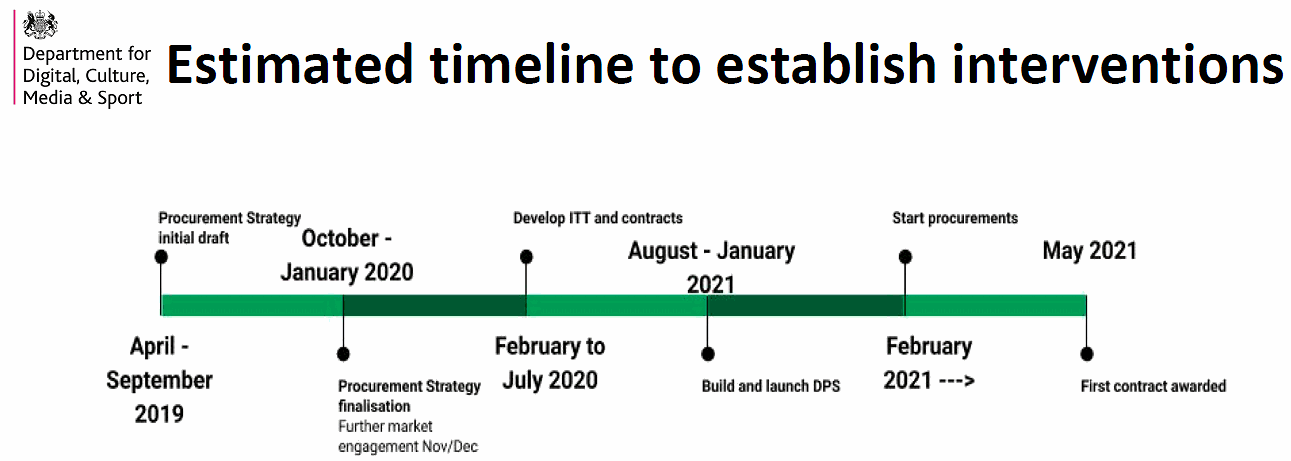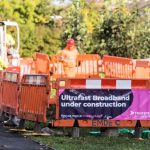BDUK – Possible Build Scenario for UK Full Fibre Broadband Rollout

The Government’s (DCMS) Building Digital UK team recently proposed an interesting build scenario for the future £5bn – state aid funded – project to roll-out gigabit-capable “full fibre” (FTTP) broadband ISP networks, which as predicted suggests that the build phase probably won’t begin until late 2021.
Firstly, let’s recap where we’re at today, since the goalposts have been shifting more times than a border in Syria. The Prime Minister, Boris Johnson, has committed to invest £5bn of public money to help deploy “gigabit-capable” (1Gbps) broadband services – via full fibre, hybrid fibre coax and or fixed wireless (5G etc.) – to reach every home in the UK by the end of 2025; focusing on the final 20% of hardest to reach premises (mostly rural).
The move to adopt “gigabit” instead of “full fibre” terminology is a sensible one in so far as it makes the 2025 date more plausible (i.e. not completely bonkers, like it was before). The main reason for that is because existing networks, such as Virgin Media’s cable platform, can now be included and this is akin to saying that, by around 2021, some c.60%+ of UK premises (mostly in urban areas) can be marked as done via commercial networks.
Advertisement
Despite the change in terminology we’re still on record as saying that 2025 would be an incredibly difficult target to hit, which is partly because it tends to take a long time before any new policy idea gets turned into a physical build (the original Superfast Broadband Programme took 2-3 years before full build began in 2012/13). A recent presentation from the BDUK team has helped to highlight this point.
BDUK’s Possible Build Scenario
The Head of Commercial, Design & Strategy at BDUK, Matt Agar, recently talked about policy development in a presentation to INCA‘s annual conference. As part of that he proposed a possible build scenario based on the old 2033 target for universal full fibre coverage under the 2018 Future Telecoms Infrastructure Review (FTIR), which reflected a reduced outside-in (rural areas first) market intervention for the final 10% (i.e. c.2 million UK premises).
The use of a presentation based around the old 2033 target is partly to do with the fact that the goalposts keep shifting (first 2033, then 2025, then gigabit-capable instead of full fibre etc.). As such BDUK has only just started on a major programme to understand how they’ll need to adapt to Boris’s new 2025 target. All of that effort could of course be cast into doubt again if another General Election is called this week.
Nevertheless the procurement, consultation and policy design process is likely to require the same amount of time no matter what the intended completion date and that’s where BDUK’s scenario can help to provide some useful context.
Advertisement

In the proposed scenario BDUK appears to envisage a procurement strategy being finalised by January 2020, which would be followed by early market engagements and other work, until February 2021 when the procurement process itself would begin.
Assuming everything kept to plan then the first contracts could in theory be awarded by May 2021, with the build commencing from around November 2021. At this point we’re a little over 2 years down the road from today and it’s all roughly in keeping with what we’d expect to see (you can’t rush it, there are complicated issues of competition to balance, legislation to pass, teams to staff and consultations to conduct).
Under this scenario BDUK suggested that the delivery, based on a standard S curve (like below), would need to ramp-up to a maximum rate of 170k premises/quarter (13k/week) and contracts should aim to complete by January 2032 (this is just for the BDUK projects rather than the cumulative market total).
Advertisement

As ever the shifting goalposts, which have moved the completion date much nearer than before, may have the perhaps ironic impact of meaning that it could take longer than November 2021 before we see the first builds begin (i.e. due to the need to develop yet another new plan / strategy).
The BDUK team appear to be acutely aware of this and so, in lieu of a new State Aid decision and procurement approach in 2021, are also examining ways to help ramp-up the build beforehand (i.e. it might be possible to squeeze more full fibre out of existing contracts, Local Full Fibre Networks schemes, Vouchers and the Rural Gigabit Connectivity Programme).
The last thing the new programme wants to see is a rollout that ramps down before it ramps-up again. Keeping that momentum going, particularly on rural delivery, will be vital if the 2025 target is to stand any chance of being achieved (otherwise operators will shift resources to their urban builds). Both BDUK and DCMS both recognise that it is a very challenging target.
Mark is a professional technology writer, IT consultant and computer engineer from Dorset (England), he also founded ISPreview in 1999 and enjoys analysing the latest telecoms and broadband developments. Find me on X (Twitter), Mastodon, Facebook, BlueSky, Threads.net and Linkedin.
« O2 UK Hails Recycling Effort – 3 Million Handsets Saved from Landfill
ISP TalkTalk Business Relaunch UK Ethernet over FTTC Service »





















































Hi, do you guys know how to find out a date that fibre will be available on my road? I still have a standard line which for this day and age is so slow. 96% of the UK have fibre, I live in Sheffield South Yorkshire and still can’t get it.